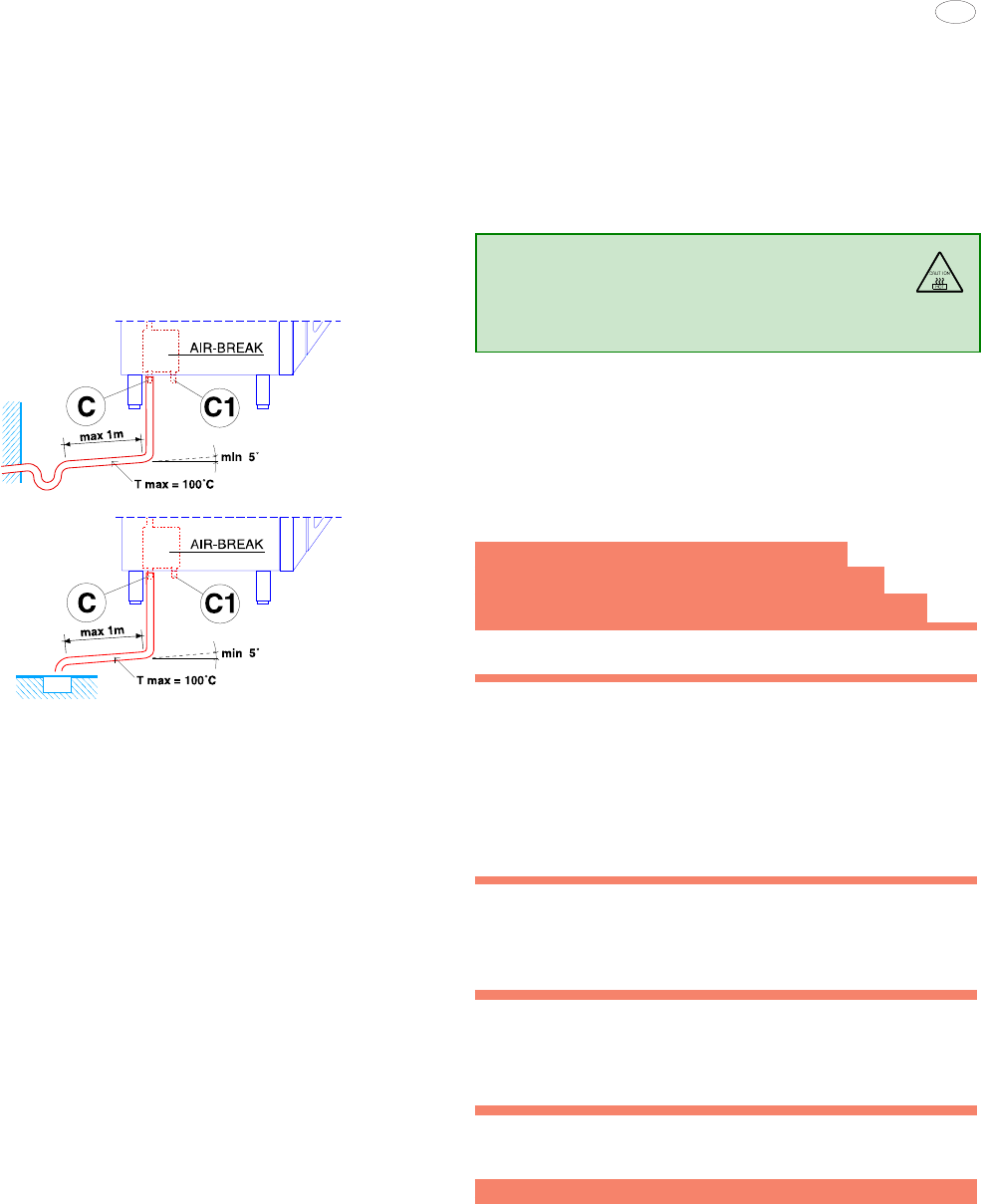
5958 992 00
EN
17
back if the oven is not placed against a wall, excluding the front
part with rack support structure. It must not be more than 3 feet
(1 metre) long, with inside diameter not less than that of the
oven discharge pipe (1" 1/4), and must withstand temperatures
of at least 212°F (100°C). Make sure there are no constrictions in
hoses or elbows in metal pipes, along the entire drain path. Avoid
horizontal sections where water can collect and stagnate (min.
slope 5%).
WARING: BLOCKING THE DRAIN IS HAZARDOUS.
C - Oven drain
C1 - Safety outlet
Important:
- Do not obstruct the safety outlet C1.
- Do not connect the safety outlet C1 to the drainage system.
Note:
If water comes out of the AIR-BREAK (safety outlet C1) this means
the drain C is blocked. Any elimination of the obstruction must
be carried out by specialized technical personnel.
5. SAFETY DEVICE
The appliance is equipped with the following safety devices:
- Fuses, see the wiring diagram, located behind the control panel.
For replacement, unscrew the holding cap and replace the dam-
aged component with another one of equal capacity; this value is
indicated on the rating plate located in the same place.
- Compartment manual-reset safety thermostat located be-
hind the control panel; it intervenes, cutting off the convection
heating supply.
RESETTING OPERATIONS MUST BE CARRIED OUT BY
SPECIALIZED TECHNICAL PERSONNEL AFTER ELIMINATING
THE CAUSES OF INTERRUPTION.
- Automatic-reset thermal device inside the fan motor, which
intervenes in case the motor overheats, protecting equipment
operation; it intervenes, cutting off the electric power to the appli-
ance.
- MAGNETRON manual-reset safety thermostat located be-
hind the left side panel; it intervenes, cutting off the power supply
to the MAGNETRON.
Resetting operations must be carried out by specialized technical per-
sonnel after eliminating the causes of interruption.
6. OPERATION CHECK
- Switch the appliance on, following the instructions in the sec-
tion “Operating instructions”;
- Explain appliance operation, routine maintenance and cleaning
operations to the user, with the help of the instruction handbook.
Important:
- During operation, pay attention
to the hot zones of the exterior surface.
- Do not place objects on the outlets located at the top
of the appliance.
- With oven hot, check the correct working of the door closing
mechanism. If necessary, adjust closing by adjusting the position
of the catch.
7. MAINTENANCE
PRECAUTION TO BE OBSERVED BEFORE
AND DURING SERVICING TO AVOID POSSIBLE
EXPOSURE TO EXCESSIVE MICROWAVE ENERGY
::
::
:
(a) Do not operate or allow the oven to be operated with
the door open.
(b) Make the following safety checks on all ovens to be
serviced before activating the magnetron or other
microwave source, and make repairs as necessary:
(1) interlock operation,
(2) proper door closing,
(3) seal and sealing surfaces (arcing, wear, and other
damage),
(4) damage to or loosening of hinges and latches,
(5) evidence of dropping or abuse.
(c) Before turning on microwave power for any service
test or inspection within the microwave generating
compartments, check the magnetron, wave guide or
transmission line, and cavity for proper alignment,
integrity, and connection.
(d) Any defective or misadjusted components in the
interlock, monitor, door seal, and microwave generation
and transmission systems shall be repaired, replaced, or
adjusted by procedures described in this manual before
the oven is released to the owner.
(e) A microwave leakage check to verify compliance with
the Federal Performance Standard should be performed
on each oven prior to release to the owner.
The components requiring routine maintenance are accessible
by opening the control panel, and the left, right and rear panels.
Danger: Live voltage is present with panels removed and unit
switch on. Exercise extreme caution when work with live voltage.
NOTICE: Using any parts other than OEM original spare parts
relieves the manufacturer of all warranty and liability.


















